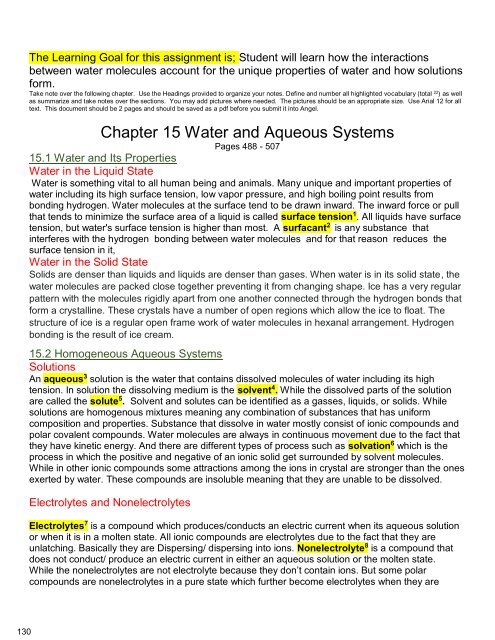Create successful ePaper yourself
Turn your PDF publications into a flip-book with our unique Google optimized e-Paper software.
127<br />
3. The pressure of nitrogen gas in a light bulb is 60 kPa at 25°C. Calculate the pressure of the gas<br />
when the temperature inside the bulb rises to 167°C after the bulb is lighted up?<br />
60/25=p/167<br />
+273 +273<br />
60/298=p/440<br />
Combined gas law<br />
298=269400<br />
p=88.590604013<br />
p=90<br />
90 Kpa<br />
The combined gas law makes use of the relationships shared by pressure, volume, and temperature:<br />
the variables found in other gas laws, such as Boyle's law, Charles' law and Gay-Lussac's law. Let's<br />
review the basic principles of these three laws.<br />
Imagine you are a diver, and you begin your dive with lungs full of air. As<br />
you go deeper under water, the pressure you experience in your lungs<br />
increases. When this happens, the air inside your lungs gets squished, so<br />
the volume decreases. This is an example of Boyle's law in action, which<br />
states that the higher the pressure (P), the lower the volume (V), as<br />
shown in this image. Here, k is any constant number.<br />
Have you ever tried putting a balloon in the refrigerator and notice that it<br />
shrinks? As the temperature of the refrigerated balloon decreases, the<br />
volume of the gas inside the balloon also decreases. When you take the<br />
balloon out of the refrigerator, it reverts to its original size, so the opposite is<br />
also true; when the temperature increases, the volume also increases. The<br />
shrinking balloon serves as a demonstration of Charles' law, which states<br />
that the higher the temperature (T), the higher the volume (V).<br />
Imagine yourself driving down a road, which can cause the<br />
temperature to increase within your tires. As a result, the air inside the<br />
tires expands, and the pressure increases. This is an example of Gay-<br />
Lussac's law, which shows the relationship between pressure (P) and<br />
temperature (T) when the volume remains constant; as the<br />
temperature increases, the pressure also increases.<br />
When we put Boyle's law, Charles' law, and Gay-Lussac's law together, we come up with the<br />
combined gas law, which shows that:<br />
<br />
<br />
<br />
Pressure is inversely proportional to volume, or higher volume equals lower pressure.<br />
Pressure is directly proportional to temperature, or higher temperature equals higher pressure.<br />
Volume is directly proportional to temperature, or higher temperature equals higher volume.<br />
Let's take a look at the formula for the combined gas law. Here, PV / T = k shows how pressure,<br />
volume and temperature relate to each other, where k is a constant number.<br />
The formula for the combined gas law can be adjusted to compare two sets of conditions in one<br />
substance. In the equation, the figures for pressure (P), volume (V), and temperature (T) with<br />
subscripts of one represent the initial condition, and those with the subscripts of two represent the<br />
final condition.



